Our garden has been a very busy place since March, so this month will be a round-up of events both horticultural and for the community.
The garden was under a lot of pressure during half term and, following the tadpole arrival, visitors enjoyed being able to see the activity in our small pond area, and we were happy to have just about enough rain to keep the water above the silt which continues to gather, ensuring their survival. The watercourse is dependent on land drainage from the surrounding area and the skate board park so a good spell of rain tops this up and enables the water to flow down through the garden with a lovely sound, so we are happy when that happens. However sunshine and a dry spell, which we all enjoy, has the effect of increasing the algae in the pond at the same time as lowering the water level very quickly. This is always going to be a difficult balancing act to manage.
Spring growth on the shrubs was set back with a period of cold winds and frost after a warm start to the season, but everything has now caught up and the shrubs are filling out well with some good colour in the new Nandina foliage. Azalea and Rhododendrons flowered during May and early June and now the Iris are giving much pleasure with the beautiful pale mauve flowers complemented by the blue Hostas.

The volunteer gardeners have put in some excellent work and are learning some new skills. Andy Bolton taught some of us how to prune the Scots Pines by shortening the new growth to promote the formation of pads of foliage, known as ‘candling’.
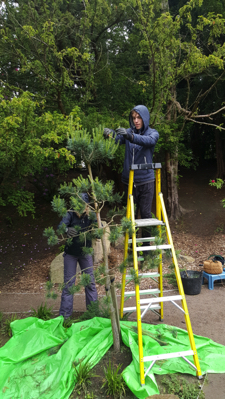
Recently we have also learnt how to construct a low bamboo fence to discourage footfall on the streamside Azalea border. Green bamboo stems were cut from the stands in the garden, cut to regular lengths, placed in the ground in a regular overlapping pattern and then the junctions tied firmly with special knots. This type of fencing is used a lot in Japan, as well as several other traditional styles. Maybe we will try some of those in the future. The exercise has proved extremely effective, and saved a lot of work in this area.

The general public continue to enjoy the garden, and we have had a counter at the lower entrance provided by Harrogate Borough Council so we await those results. There have been several guided walks which have included the Japanese Garden in the route, in particular a group from Ebor Arts Society York, and Japanese Garden Society North West and Yorkshire and Humber Regions; both groups enjoyed their visit and were very complimentary. Some of the JGS group had been involved in the construction, and early pruning, so it was particularly gratifying to receive their praise for all our hard work.
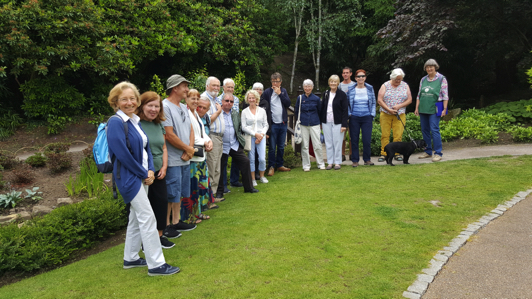
During May the garden had an influx of young artists from Western Primary School. 50 children in several groups had the opportunity to learn about the Spa History of Valley Gardens with a visit to the Old Magnesia Well Pump Room and a quiz, followed by a session of drawing in the Japanese Garden. They have produced some lovely art work from their sketches which will be on display in their board by the playground and in the central notice board in time for ‘Britain In Bloom’ judging on August 1st.

We have not neglected Health and Wellbeing either. The first of two roll-up free Yoga sessions was held last Saturday in good weather. Exercise mats were laid out on the grass, and the garden was a calm and scented place for their exercise routines. Being able to exercise in the open air is extremely beneficial.
March 2019
Despite some wet and windy weather this week, there are signs of spring in the garden. Since the New Year the volunteer gardeners have spent some time in the Japanese Garden as well as in other areas of Valley Gardens, concentrating on putting bark mulch onto the areas which took a lot of weeding time last season, and topping up the woodland path and steps; also keeping the watercourses free of leaves and twigs.
The early cherry blossom has been very attractive, and the new Prunus Mume (Japanese apricot) flowered really well this year, showing it will be an excellent addition to the garden trees. We also seem to have dissuaded the squirrels from feasting on the Camellias, so hopefully a better crop of blossom to look forward to. The remedy would seem to be a mixture of spiky Berberis cuttings around the base of the shrubs, and spraying the buds with a dilution of chili powder!
The arrival of some very active frogs laying their frog spawn during the half term holiday gave families some interesting ‘wild life’ viewing but did put pressure on the beds along the watercourse. Not too much lasting damage however.
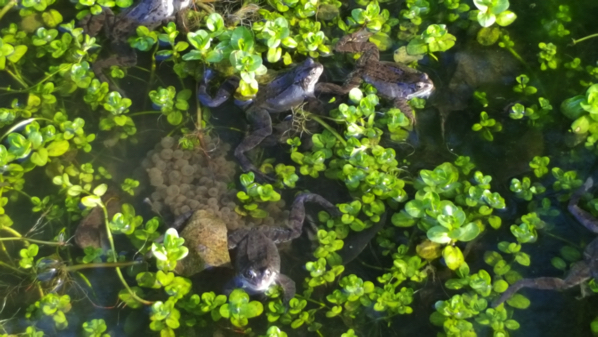
The visit to the garden by the Japanese Exchange students mentioned in the December blog did take place, accompanied by their Rossett School hosts; you will see from the images that they were interested in our garden, and I was able to tell them a little about the project through an interpreter.
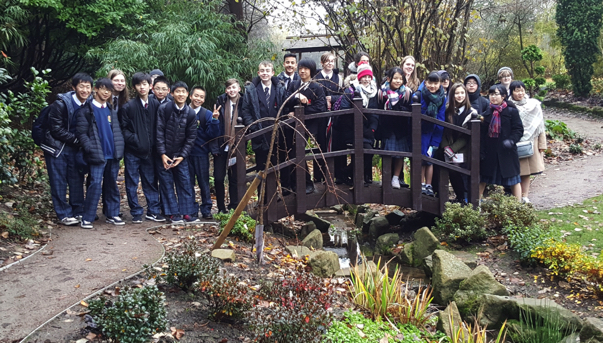
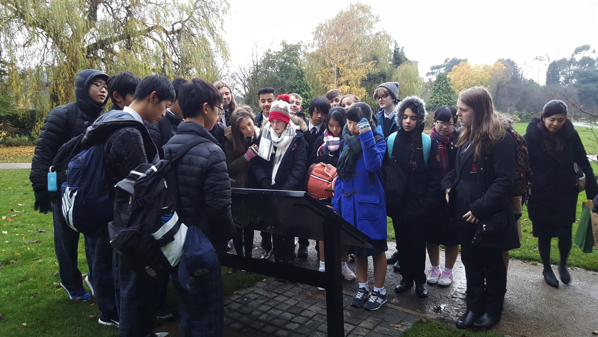
We have two dates this year for Japanese Garden Society events, both of which will be interesting. The members attending the Yorkshire & Humberside Regional Annual General Meeting on March 30th 2019 at Harlow Carr will be visiting the garden following three talks on the restoration of Japanese Gardens both in the Scottish Borders, at Cowden Castle, and here in Harrogate. Then on October 12th 2019 the National Society will be holding its Annual General Meeting with a day of lectures on Japanese Garden Maintenance here in Harrogate at The Crown Hotel. Details of this meeting will be found on the website nearer the time.
December - Winding up 2018
It has taken a little while to recover from the excitement of our two-day Japanese Festival for the official opening of the garden on October 17th. Now the bills are paid, and we are left with some very happy memories and a few copies of our Commemorative Book for sale at cost (£16); if anyone is interested please contact Liz Chidlow through the garden volunteers email on the home page.
The Sogetsu Ikebana demonstration which we held on the evening of the 18th of October was well attended and enjoyed by all. Deborah Hathorn managed to create seven large and very varied arrangements in the one and a half hours, see pictures below. The event was supported by both the Japanese Shop and Travelgate again, and also by Sandie Ogden with her collection of kimonos. Ed who works at West Park Antiques, wore one of Sandie’s kimonos and dazzled the punters to get them to part with £283 in raffle tickets, which, with the ticket money more than covered our costs.
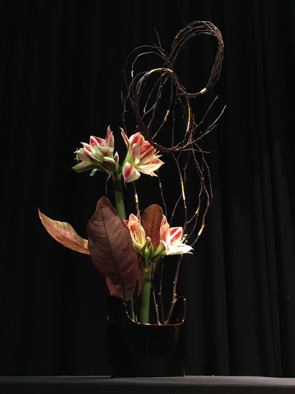
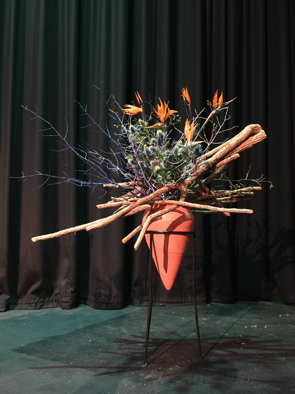

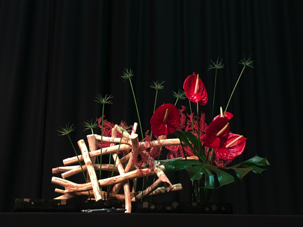

There has been a little volunteer time spent in the garden to tidy leaves, particularly from the pebble stream which soon gets clogged up, but our time has been spent preparing for the next opening ceremony; the King Edward VII Gates and adjacent Memorial Rose garden which takes place on Monday November 26th.
A group of Japanese students are due to visit the garden tomorrow, they are taking part in the regular exchange programme between Rossett School and a school in Japan. We will make sure to have a photo from their visit on the blog page soon.
October 2018 - The Opening
On Wednesday October 17th 2018 the Garden was opened and named ‘Shijima no niwa’ by the Japanese Ambassador Extraordinary & Plenipotentiary to the UK, Koji Tsuruoka, who was accompanied by Counsellor Shimizu from the Tourism and Transport office at the Embassy.
The sun shone all day, and the weather over the last week had been just right; not too much wind to destroy the lovely autumn colours and enough rain to fill the watercourse. The garden looked magnificent following the hard work over the past three weeks by our wonderful volunteers, including Ichini and Hachi (Joe and Steve) who came over from Manchester expressly to prune the Junipers. This provided a good opportunity to show both volunteers and garden staff the pruning technique we will need to learn to keep these shrubs looking their best in years to come.
Setting Up Wednesday commenced with the arrival of ten gleaming vehicles from our sponsors; Nissan, Toyota and Lexus, the parking of which was ably organised by Peter Blayney and John Moor. Two very smart display boards, loaned from HBC, were set up in the Sun Pavilion to show scenes in Harrogate District and the restoration of the garden. The cheese donated by Shepherds Purse Cheeses was given to Stuart for the buffet table, and the gifts we intended to present, which had been beautifully wrapped by the Japanese Shop for us, were secreted away to be presented later. Our other sponsors, Travelgate and The Japanese Shop, arrived with Slingsby Gin and Harrogate Spring water soon to follow. At about 11.00am Liz and I took the cover she had prepared for the carved boulder and some red ribbon to seal off the garden, one Mother and toddler were rather reluctant to leave! Then it was time to await the arrival of our guests.
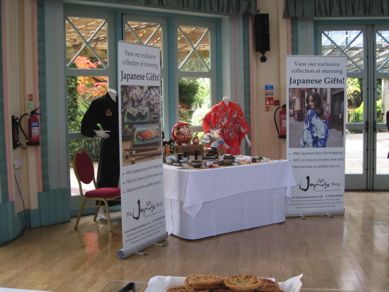
The Itinerary Thankfully the trains were running to time and the Harrogate Mayor, Cllr Bernard Bateman, met the diplomats at Harrogate station, with the assistance of the station supervisor John Bassinder to ensure that they found their way from Platform 3 to the main foyer.
On arrival at the King Edward VII entrance gate the party was greeted by Jane Blayney Chairman of Friends of Valley Gardens; and introduced to Mrs Linda Bateman, Christopher Legard High Sherriff of North Yorkshire, Sue Mendus from the Heritage Lottery, Martin Fish President of the Friends, Graham Hardman Japanese Garden Society and garden designer, Patrick Kilburn Head of Parks and Environmental Services, and myself.

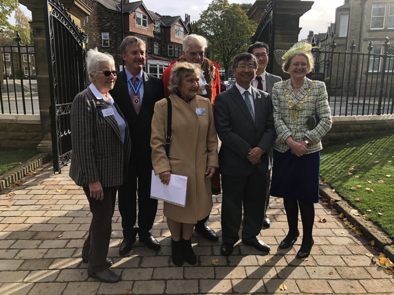
We then processed down to the upper gate of the garden where Chloe, Sam and Oliver, students from Rossett School whose designs we had chosen for the information board and publicity material, were waiting with their head of department Holly Davison-Lobley to meet the Ambassador. He was very interested in their work, and talked about it quite a lot to us and to others he met during the course of his visit.

As we approached the lower gate there was a good crowd awaiting us to observe the opening ceremony. The Ambassador made an excellent speech, praising the fact that an earlier garden had now been restored and that the work had been driven entirely by the Friends of Valley Garden volunteers. Liz had created a red and white segmented semi-fitted cover for the carved boulder which had been installed a few days previously; red and white being celebratory colours in Japan. Following revealing the name the Ambassador explained the derivation of the name Shijima which has arisen from poetry, and is not in general use (as explained in a previous blog). The Ambassador then cut the ribbon with great ceremony, and enjoyed a walk through the garden joined by many of our guests.
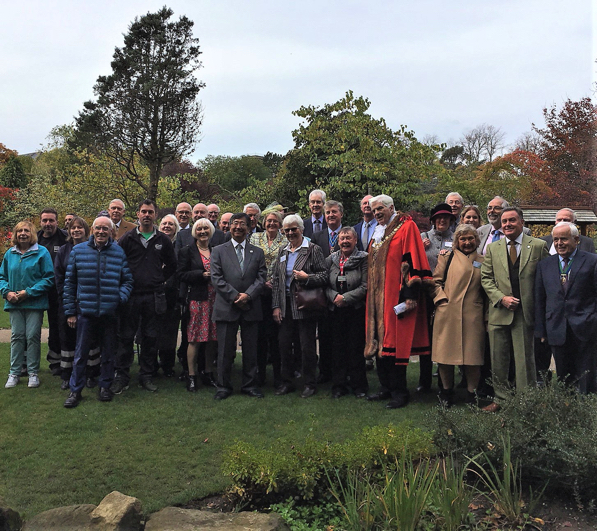
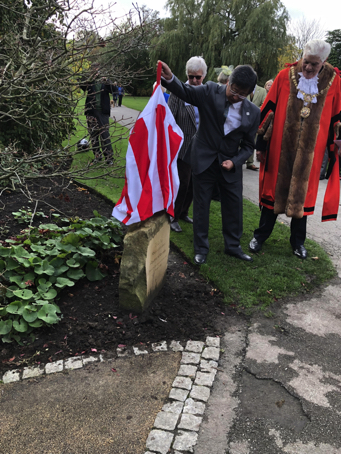


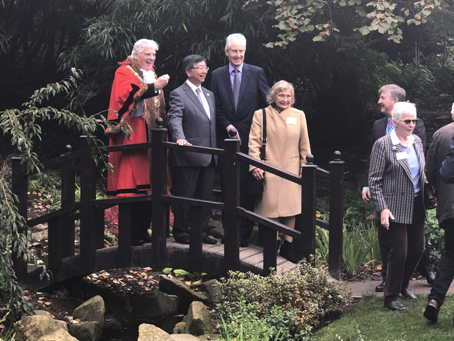
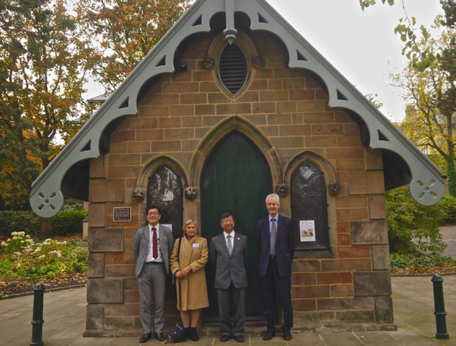
An excellent ‘Best of Yorkshire’ buffet lunch was given for up to 70 guests in the Sun Pavilion with a gin and tonic of your choice served by the staff from Spirit of Harrogate in a large goblet with plenty of ice, wonderful. We were pleased to ask the Mayor to present a gift of Malcolm Neesam’s new book, Harrogate in 50 Buildings’ to the Ambassador; Malcolm was present at the reception and was presented. The High Sheriff then presented the gift of a golden Japanese designed spade to Graham Hardman, and 15 commemorative books to those whose work has been so significant in achieving this project. Following the lunch the diplomats were taken on a tour of the historic buildings in Harrogate which relate to our Spa History, by Jane Blayney and Kate Dawson, all of which featured in his new book.
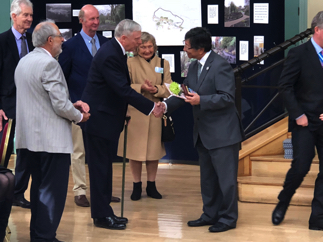
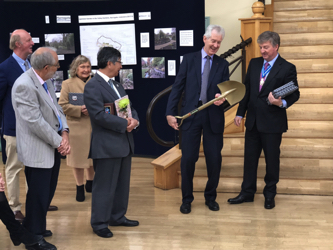
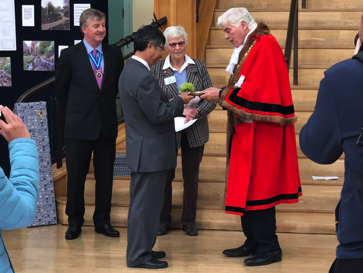
The Ambassador had been invited to take a tour of Ripley Castle with Sir Thomas Ingilby the following day, so we were able to include tours at Spirit of Harrogate and Harrogate Water Brands, both of whom are hoping to export to Japan in the near future. The Ambassador told directors at Harrogate Spring Water that the Japanese would enjoy using such an excellent product with their whisky! He also applauded the marketing strategy of Spirit of Harrogate and wished them well. Lunch at Betty’s Harlow Carr followed. The Diplomats finished their visit with a tour of Knaresborough Castle accompanied by Kate Dawson, before boarding the train back to London via York.



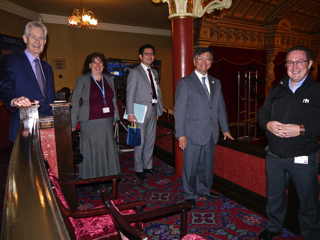

So a really big ‘thank you’ to everyone who helped to make this two day visit so successful. Both Liz and I were very impressed by Ambassador Koji and Counsellor Shimizu, who were great company over the two days and seemed able to relax and really enjoy their first visit to Yorkshire. Both have subsequently told us that they will be returning with their families to discover more of our beautiful county.
Following this there will be more on the regular blog when I will write about the Sogetsu Ikebana Demonstration at Ashville College on the Thursday evening. Subsequently we will report intermittently on anything of interest.
September 2018
Planting completed for 2018
During September we had a further plant delivery from Johnsons of Whixley. This mainly consisted of additional ground cover plants, and some tough planting in front of the Crane rock arrangement as the previous planting had been damaged by continuous trampling. In addition we have tried to fill gaps where some of our visitors have continued to walk where we would rather they did not! (see most recent images)
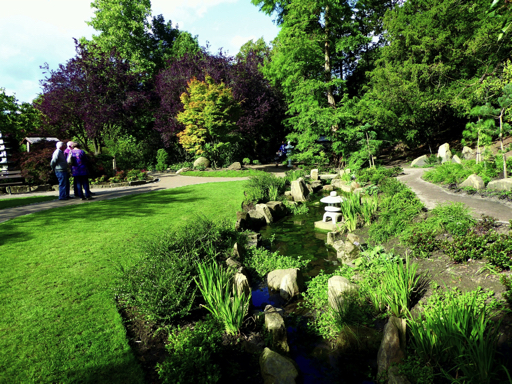
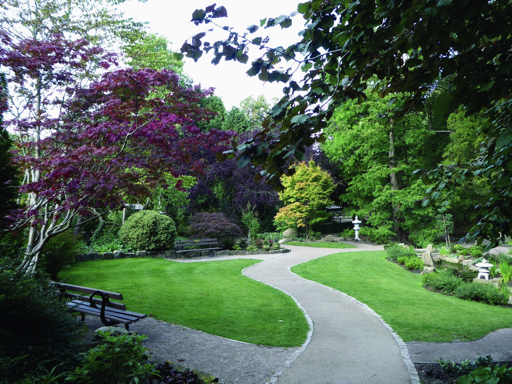
We continue to experience difficulty with the dry weather conditions, although the sunshine is lovely, trying to ensure that all our new shrubs remain viable through the winter and watering those which are trying to produce next year’s buds. For the next three weeks the volunteer gardeners are concentrating on getting the garden as pristine as possible for the opening event on Wednesday October 17th. There will be some instruction on specialist pruning techniques from our Japanese Garden Society friends on the morning of Tuesday October 16th.

Ann delivering more plants!
Ikebana.
In preparation for our fundraising Sogetsu Ikebana event on October 18th at Ashville College, see Friends Page for details, I am thinking about the history of this popular Japanese art form.
I was delighted to find a book called ‘Origins of Ikebana’ by Elizabeth Palmer at the second hand book shop on Commercial Street in Harrogate a few weeks ago, and I have gleaned the information below mainly from this book.
IKEBANA is derived from two words IKIRO (to live) and HANA (flowers and branches). In Japan there are many paths to enlightenment or self-realization through the careful study of art forms, and this is one of them.
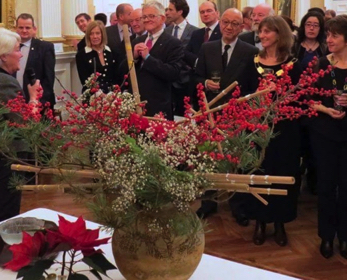
Ikebana styles are very varied and range from careful detailed arrangements of a small number of elements to almost sculptural proportions when constructed from tree trunks, metal, and stone and wood, and represent deep feeling for landscape and the power of nature shown through the Shinto religion.
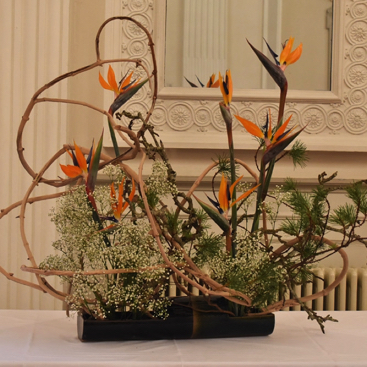
The art developed as early as the 7th century in the temples, so the first Ikebana artists were all priests. By the 14th century flower festivals were very popular, and by the 15th century the desire to learn about Ikebana had reached the aristocracy amongst the court nobility and the Samurai. Until recently only the men were taken to be serious Ikebana artists. More recently during the last century the art form devolved to the west through military wives learning the art whilst living in Japan.
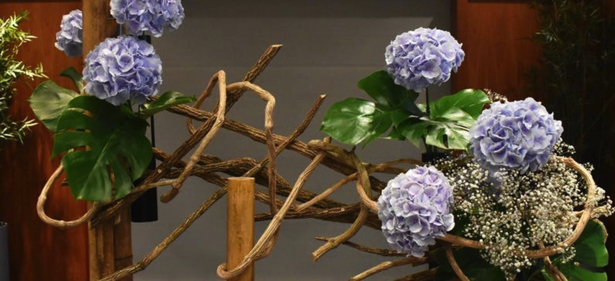
July 2018
About the Naming of the Garden and its Official Opening
Shijima no niwa ‘Garden of Serenity’
If we go back to September 2017 when the garden had just been reopened after the contractors finished and people began to wander through, they liked what they saw and we had many lovely chats with visitors and locals about the garden and the planting plans. One morning someone came and took some pictures, one of which he posted on Twitter with very appreciative comments about what Friends of Valley Gardens had achieved so far, looking forward to when it was all planted up. So I responded, with some trepidation being new to Social Media back then, thanked him and asked if he had any suggestions about a name.
The name ‘Shijima’ was suggested, meaning ‘Stillness’; we liked this as visitors have continually told us that the garden’ feels a calm space’, ‘is so peaceful’ ‘has a feeling of serenity’.
So we passed this on to Graham Hardman our designer and he liked it too. However he said we would need to take advice about how to express the name correctly in Japanese. The advice of a specialist would be sought. After all IF we did get the Japanese Ambassador to open the garden it would need to be correct! Subsequently we have indeed gotten the Japanese Ambassador coming to open the garden on October 17th 2018.
Sometime later we finally got a detailed response from Graham’s expert; ‘Shijima’ has a poetic use in Japanese and as such has no single Kanji, the Japanese picture language, to represent it. Instead it has two Kanji, one for Tranquility and one for Serenity. As the word is not generally understood it also needs to be represented in the Hiragana text which describes phonetic sounds, so that the word can be read accurately. Finally we did need to include the Kanji and the word ‘Niwa’ which means garden and discover that it should be placed after’ Shijima’
(See image) So, looking at the full illustration the top row is the Hiragana text representing phonetic sound; Shi ji ma ni wa.


The second row is the Kanji, from the left Tranquility, Serenity and Niwa and Hiragana ‘no’ meaning “of”, thirdly the name in Japanese and fourthly in English.
For the official opening the Ambassador will enter the garden at the upper entrance where we now have a very smart information board with art work by Chloe from Rossett School, print work by “Colour it In” from Ripon and installation by Bob Cowell our local ‘to do man’ (see image). He will have a walk round with the designer and project team and then at the lower entrance will unveil a rough boulder which has been carved with the name in full, as above, and date of the opening. 
June 2018
Wellbeing Sessions in the Japanese Garden
‘Wellbeing’ is a buzz word at present, and those of us who work in the Valley Gardens are aware that being in the garden and working with a team does give a sense of wellbeing. Garden visits and volunteering in gardens are being suggested by our health specialists and highlighted by the RHS at their garden shows.
Japanese Gardens in particular have been shown to have a calming effect which is very beneficial, and Japanese Gardens in the USA, Portland Oregon in particular, are used for Mindfulness Sessions. So if you add the benefits of Tai Chi and Yoga into the mix it should be really good.
That is what we have done. We have teamed up with the Yorkshire Centre for Wellbeing on Duchy Road and they are doing free 45 minute sessions in the Japanese Garden once a month through the summer.
So far we have had two sessions, the first in April somewhat curtailed by a snow storm, but the May Bank Holiday Monday was glorious and James led us through the basic Yoga standing postures followed by some meditation relaxing on mats under the trees, which was just wonderful. 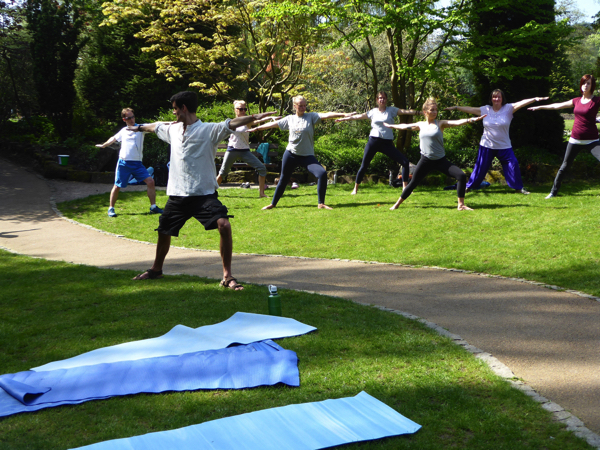


The dates and times for the rest of the sessions are shown below and on the events section of the main page of the website.
June 23rd at 11.00am with Anne-Marie who will work with our surroundings, and move around the garden.
July 14th at 11.00 with James for Hatha Yoga
August 11th at 11.00 with Anne-Marie
September 15th at 11.00 with Chris for Tai Chi.
Spring Blog - March to May 2018
How the time has flown by since my last blog, we are into early summer already, so apologies to my readers.
Spring is a time for planting, and that is what we have been concentrating on for the last three months. Johnson’s of Whixley delivered the spring plant order in March, and with a good volunteer session which included Graham Hardman the designer, we got the job done. Part of the additional work was to create the planting areas on the near side of the stream which needed Graham’s input. These have been filled with Azalea and Lonicera for shaping with more small Hostas. 

We have also completed a Garden Guide which will be available for guided walks in the garden, and an information leaflet to be distributed to outlets around the Harrogate area. The leaflet has been designed by Sam Corazzi from Rossett School as part of the project link with Rossett, so we are delighted that this has come to fruition and it looks very professional. This leaflet will shortly be available to download from the website.
Yorkshire’s variable weather can make things difficult for the garden. The spell of wet weather caused the watercourse to rise considerably, and some plants alongside the stream are still recovering. Now the sunshine has contributed to a bloom of green algae. Frog spawn, frogs, toads and Newts were all transferred from the boating pool during the monthly clean by the gardeners, so we cannot be too radical with cleaning the watercourse in case we disturb the tadpoles for all these species. 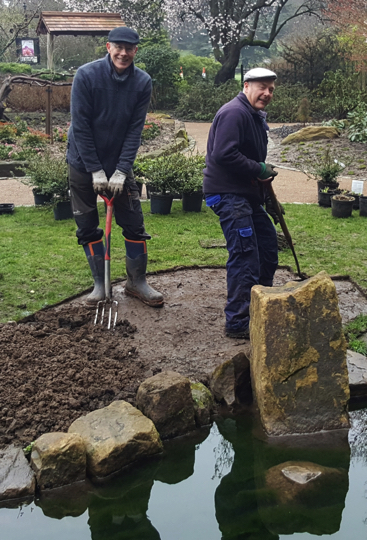
To catch up with the blog page, the next blog will be about the Wellbeing events kindly sponsored by Yorkshire Centre for Wellbeing on Duchy Road.
Winter Blog - February 17, 2018
‘Visions of Paradise’ - Japanese Gardens in the UK
The sun has come out as I start to write this giving a hint of spring in the air, the soil in the garden is very wet following continuous days of rain, and the squirrels have decided that the fat Camellia buds are a delicacy for which they are prepared to risk life and limb, despite our efforts to deter them.
Nevertheless we have had a very busy time during January and February with the ‘Visions of Paradise Exhibition’ at the Bath House Gallery, RHS Harlow Carr gardens, which we hope many of you will have already visited. This six week exhibition has been curated by both the Japanese Garden Society (JGS) and Friends of Valley Gardens Japanese Garden project team. Planned over a year ago, and welcomed by Harlow Carr as an interesting exhibition for the winter period, it opened on January 8th and the doors will close next weekend on Sunday February 25th, by which time we will have had hundreds of visitors. Although I don’t have figures to report as yet, we have been counting for set periods when we are there as stewards each weekend, and occasionally during the week.
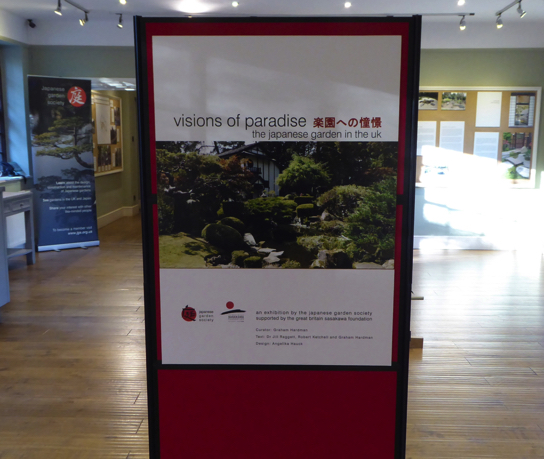
For the JGS this is part of a larger exhibition with additional material which has already been shown in other parts of the country, and includes an example of a small Karesansui (dry) garden designed and built by Andy Bolton the coordinator for Yorkshire and Humberside branch of the JGS. (see image below)
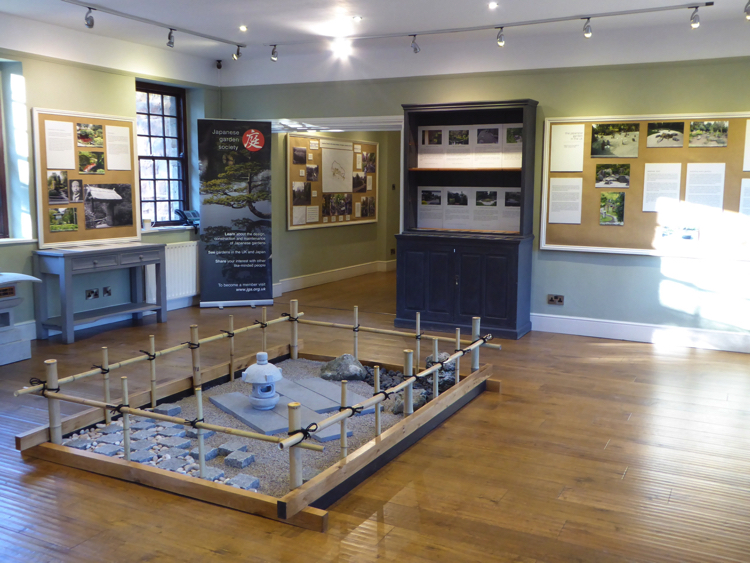
In the FOVG section we have included material on the restoration itself and information concerning the projects running at three local schools, Harrogate High School, Rossett School and Grove Academy. At the High School one GCSE group have now completed their module on Japanese art and copies of their final pieces are displayed. Rossett year 9 Graphic art students show work in progress, of which more in another blog, and Grove Academy show the student designs for the Japanese inspired Time Out space which we are helping to coordinate for them and raise additional funds, again the subject of a future blog when the construction has started. (see images of panels and model)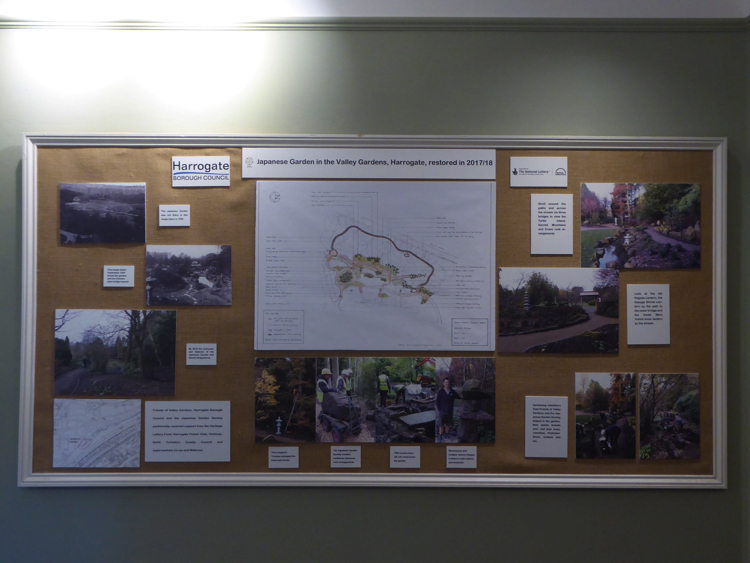

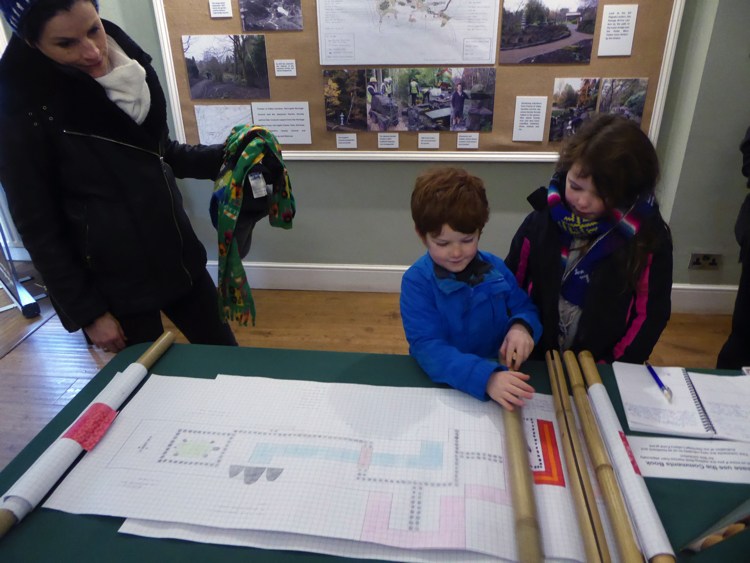

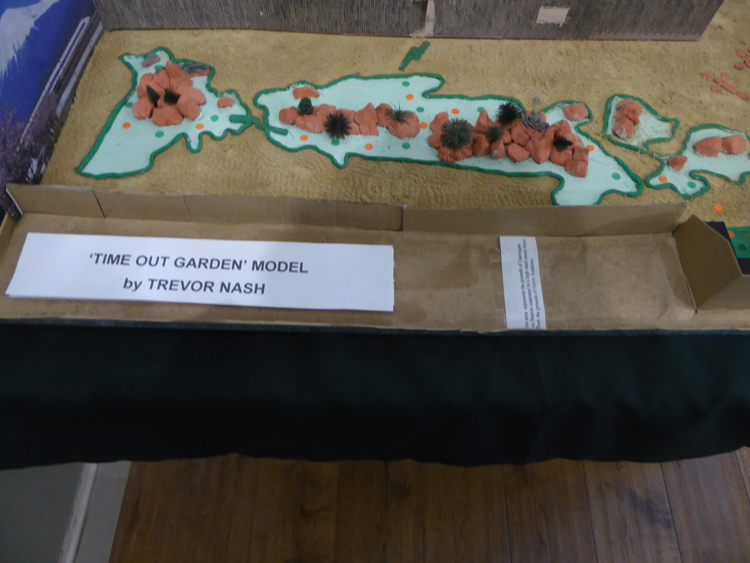
In addition to the main exhibition space the old library has been turned into an excellent gift shop by ‘The Japanese Shop’ a retail and online company based in Harrogate who deal in quality Japanese merchandise. The shop is certainly a draw for garden visitors, and Jez and Hiromi Willard, who have staffed the store nearly every day for six weeks, are surprised just how many of the visitors have visited Japan, or want to discuss a future visit with them. 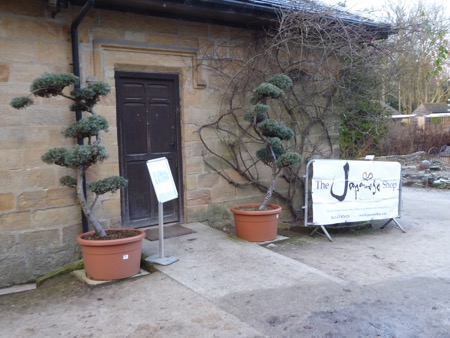
In what little space remained we decided to invite local groups with Japanese inspired interests to come at a weekend and demonstrate their hobby to our visitors. The first weekend Anne Allan, Chairman and Secretary of the Chinese Brush Painting Association, along with other members and the Harrogate and Nidderdale Art Group, demonstrated the art of using the special Chinese paint brushes which hold several colours at once to paint flowers and butterflies. Anne responded to visitor requests and painted a wonderful eagle for one young boy to have in his room, which I am sure he will cherish. This additional event certainly drew in the crowds.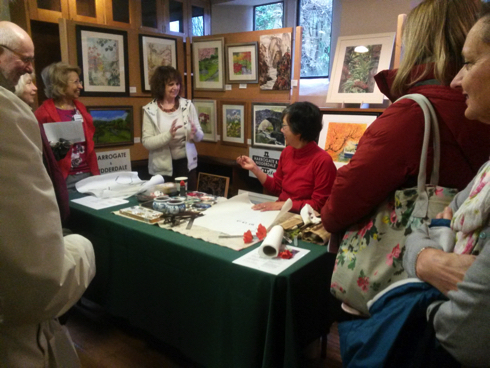
The Harlow Carr Bonsaii group set up a small exhibition of beautiful specimens for another weekend and had some interesting conversations with visitors. They meet several times during the year upstairs in the Bramhall Centre and welcome visitors to their displays where members are working on individual specimens advising each other. 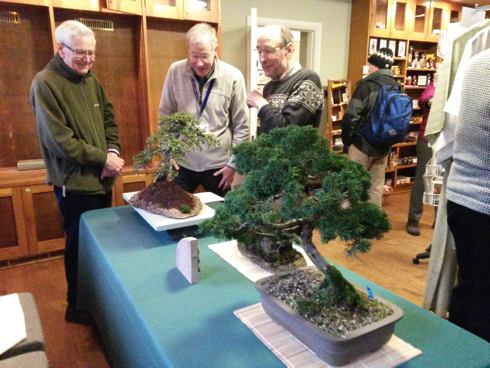

A more unusual hobby is ‘Sakuseki’ or collecting special rocks which show natural sculptural forms. Two members showed their collection on a particularly wet weekend, but weren’t without some enthusiastic support.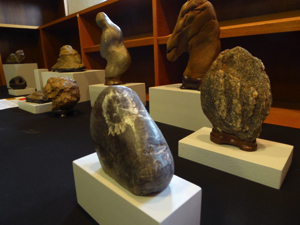
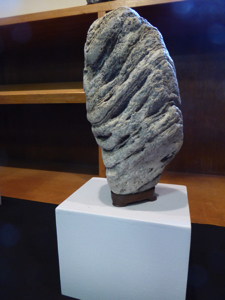
I feel we can say that this exhibition has been an unqualified success; the groups have made some valuable new contacts, and hopefully gained new members for both societies.
Once the exhibition is packed away we have to consider that Spring is coming and we need to finalise our choice of additional plants required for spring planting, get them ordered, delivered and call all volunteers back to work in the garden. I repeat our invitation to anyone who is interested in joining the groups to get in touch through the website contacting Liz Chidlow. We have by no means finished. We still need volunteers for events in the garden during 2018/19, including the official opening later this year.
December 2017
Planting the Japanese Garden
As I write this it is a dark wet December afternoon. We were lucky during November and early December that the days we planned to plant all our newly purchased plants, and the generous donations from our friends and colleagues, the weather was dry and sunny at times. There will be some more plants coming in the spring to fill the areas of soil still looking bare, in particular the wide empty edge of the Turtle Island. The plan here is to try out a thyme lawn. This has worked well as ground cover in other gardens the Japanese Garden Society (JGS) manage, and we hope it will work for us too. We will need around 500 small plant plugs of Thyme from a specialist grower like Norfolk Herbs and they are only available for spring planting.
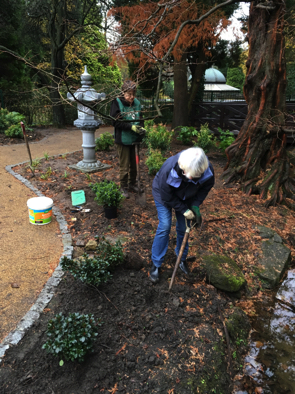
The autumn planting has been a mammoth task, involving 10 volunteers plus Head Gardener Simon and Mike his assistant; they were very supportive, as it was they who took the trailer up to the nursery repeatedly for us to collect the plants from store and bring down extra soil and mulch to mix in as we planted.
I have calculated that there were 250 hours of hard volunteer labour over eight days. Sometimes we didn’t get it quite right and several plants were moved to a better, more Japanese style group and replanted. It was only the squirrels who were less than helpful, they decided that the buds on the newly planted camellias were very tasty and calmly harvested them in front of our eyes, to our great dismay. A solution was found by Simon in the form of pieces of old tennis court net which I fixed around the most tempting of the plants using bamboo and that does seem to have discouraged the little blighters!
Soil conditions are on the acid side of neutral across the garden, with drainage being an issue particularly in areas next to the watercourse. Additional drainage has been put in by the contractors mainly on the lawned areas. There is a lot of shade and partial shade which influences what we can grow; this is an advantage when it includes beautiful evergreen ferns and clumps of Hosta. On the wooded bank we are encouraging the existing moss to spread by keeping the leaf litter down. Leaves will be collected and allowed to rot down and encourage insects and wildlife in an area just beyond this garden. Moss is loved by the Japanese and I have noticed how the late afternoon sun catches the clumps and they glow like emeralds, really beautiful. The long shrub border on the main garden side acts as an interface between the main garden and the Japanese garden. Within the garden we have chosen plants which originated in Japan wherever possible, and these will gradually take over as they mature.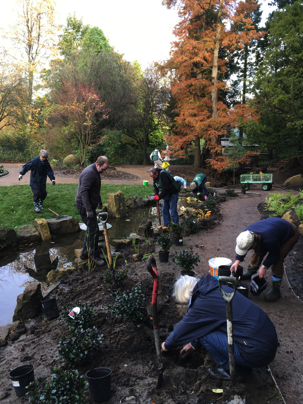

The planting plan is to use mainly evergreens for year round interest, with seasonal colour provided by blocks of similar varieties. The year starts with the mature Cherry blossom on the boundary with the boating lake in early February, continues with coloured new foliage and flowers of the three varieties of Pieris lighting up the area towards the flat bridge. The camellias follow; we have chosen the tall Adolph Audusson, a semi double red, and Whisley White which has lovely golden stamens. The mature rhododendrons and Japanese Azaleas in tones of light red and white in rounded groups on the far side of the stream are next. Up near the entrance we have five new semi mature rhododendrons variety Horizon Monarch which have light apricot buds opening to creamy yellow flowers, they are full of buds for us to look forward to. Mauve and cream Japanese iris flowers will follow and then our two new spring flowering cherries; what a feast for the eyes it will be. Summer and into early autumn is mainly hydrangeas and the shapes of the evergreen shrubs which will be trained into gentle domes, not round blobs, then the glories of autumn foliage from our mature Acers. Winter allows us to appreciate the shapes of trees, the newly planted pines which will be pruned in the Japanese style, the architectural structure of the Fatsias and scent from Sarcococca, the winter box. Mahonia variety Winter Gem is flowering well now by the upper gate and the stand of golden stemmed bamboo given to us by a local resident will look more striking as it matures.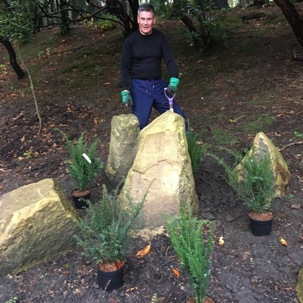
We hope you will enjoy exploring the garden through all the seasons and watch it gradually mature over the next few years. We are always happy to have new volunteers join us in the garden. We will all be learning new pruning techniques from the experts at the JGS to keep our garden looking good over the years to come. You will find contact details for volunteering on the home page.
January and February are busy months as the project is represented at the JGS ‘Visions of Paradise’ Exhibition at Harlow Carr from January 8th to February 25th see our Facebook events page. More on this to follow.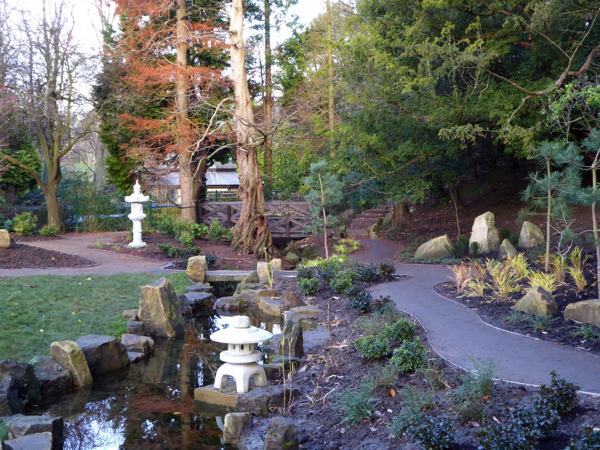
November 2017
A Day Trip to Batsford Arboretum
A day trip to Batsford Arboretum near Moreton in the Marsh to collect a Cherry tree: A Prunus Amanagowa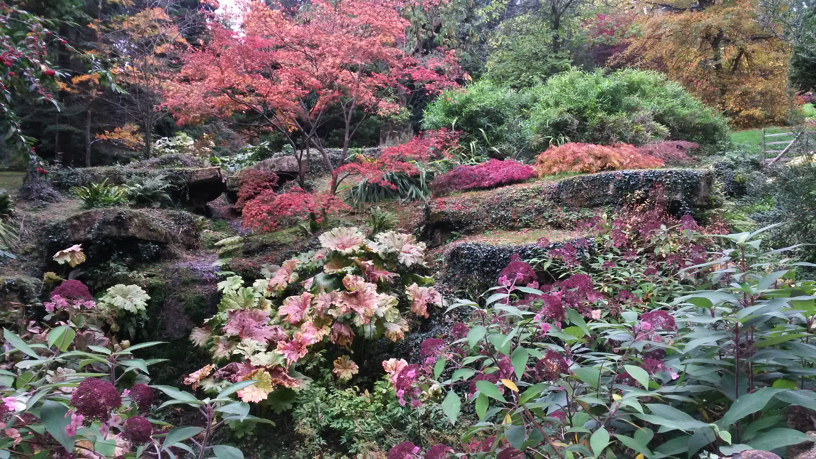
The story is that during correspondence with Matthew Hall, Head Gardener at Batsford, following up an article about Ginkos from Hiroshima in the Garden magazine, the Japanese Garden was promised the gift of a Cherry Tree. Batsford hold the National Collection of Japanese Cherries, and as they wouldn’t part with a Ginko the cherry was offered instead. It was time to go and collect it, having first ascertained that I could get it into my Kia hatch back!.
This 55 acre estate was inherited by Algernon Bertram Freeman-Mitford, Grandfather to the famous Mitford sisters, in 1886, and was in fact the very first Asian styled garden to be created in England. ‘Love in a Cold Climate’ by Nancy Mitford was written during the time they lived here.
‘Barty’ was a British Diplomat who became second secretary to the British Legation in Japan following a stint in Shanghai, and was said to have fathered at least two Japanese children during his time there! He developed an interest in their garden styles, and upon inheriting Batsford Estate decided to landscape it in the Asian style with imported bridges, statues including a large Buddha, and a Japanese rest house to grace the grounds. (see images) According to Matthew he was not particularly interested in plants, and it was left to subsequent generations to plant the many wonderful acers which were providing such wonderful colour in the garden for my visit on that sunny Sunday.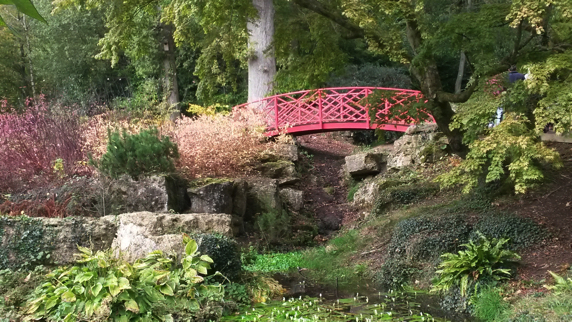
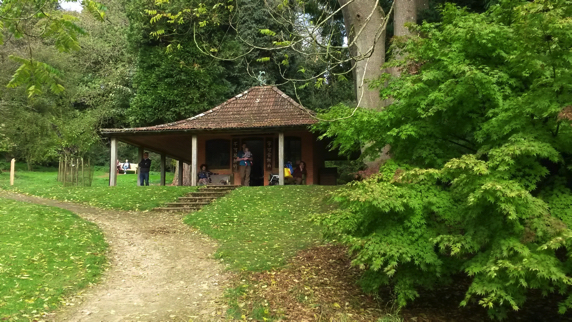

A newspaper article of the time described the landscaping;
The first process was to hew a wide glade through the wood leaving here a lofty fir and there a group of hollies, and preserving a belt of trees to form a sheltering circumference. Next a deep ravine was boldly gouged for half a mile or so, and by cunning engineering enough water was collected to send a small rill down it. Still, there were no rocks, not even a stone; and a ravine with earthen sides differs no whit from a railway cutting. These had all to be brought from a distance. Huge blocks from oolite limestone – many thousands of tons of them, some of them weighing each as much as seven tons, were carted from a quarry about a mile off, and all these great slabs and blocks from one end of the glen to the other, were laid so as to conform to the dip of the native beds so as to give the impression of a rocky gorge which the puny streamlet has prevailed to cut out in the course of ages. Of course cement had to be used, but it has been used so cunningly as to deceive the very elect, even the bed of the stream had to be laid with cement or the water would have soaked away out of sight.
I expect all that took a little longer than recreating the watercourse in our garden, but we can empathise with Barty as he worked to create his dream.
I enjoyed walking around the arboretum and discovering some of its 2,900 trees, along with many others. I found the rest house, several red bridges (see the blog on bridges as to why ours are not red), and the large Buddha.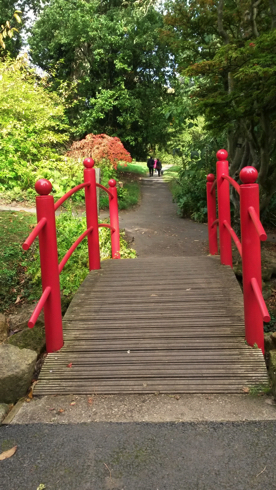
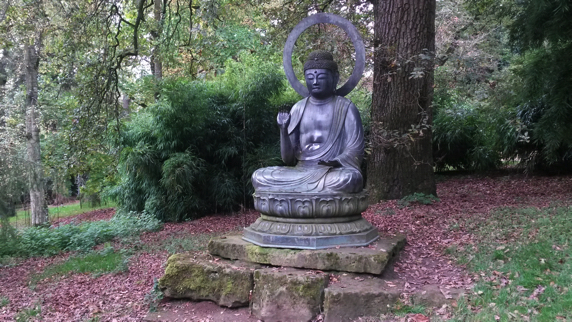
Barty described the Buddha in his memoirs; ‘high up in the wildest part of the garden, under the shade of a spreading oak, there stands, or rather sits, turned towards the East, as is fitting, a bronze statue of Buddha of heroic size. His hand is raised in the attitude of preaching; his features are expressive of the holy calm and noble abstraction which are traditional in the effigies of the great reformer; the centre of the skull is slightly raised and between the brows is a curl, representing the wind, the mystic white lock.’
My browse around their plant area resulted in buying an Acer and several lovely evergreen ferns which are all now planted in our garden, although the tree has yet to be as the site still needs further preparation. A pleasant drive home via the Fosse Way, and a cuppa with Liz and Steve as I dropped off the plants for safe keeping, ended a full days outing.
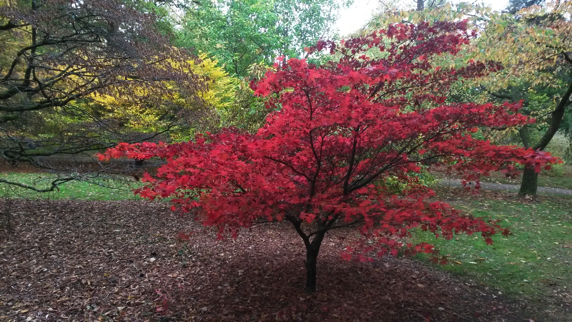
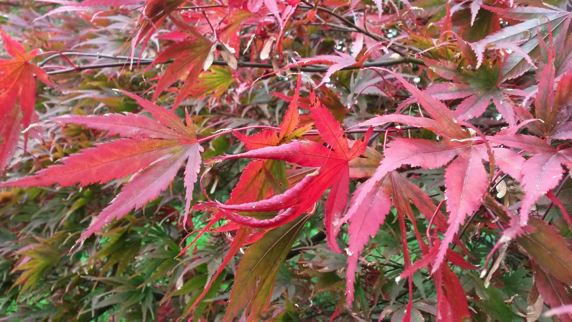

By December we should have completed the planting of our current stock of plants housed up at the HBC nursery; so my next blog will concentrate on what the hard working volunteers have achieved.
October (Just!) 2017
PLANTS AND THEIR SYMBOLISM WITHIN JAPANESE CULTURE
We have reached the point where we are going to plant up the garden, an exciting time. Our plant list contains many of Japan’s favourite varieties which we hope will give authenticity to our design. Plants included in Japan’s private gardens are not always used in their public spaces. The focus will be on evergreen shrubs and blocks of single varieties rather than the Western style of mixed borders.
I think, following Spring Watch this year, many of us are aware that one of the special trees in Japan is the Cherry. It is revered for the transience of its blossom and the Japanese have a Festival to celebrate the peak blossom time called ‘Hanami’ when people picnic under the cherry trees. We have been given two new Cherry trees to plant, Prunus Amanagowa from Batsford Arboretum and Cheale’s Weeping Cherry from our friend Yoko, a local resident. There are also two trees up on the woodland boundary over Valley Drive and several early flowering Cherries along the boundary with the boating lake. Other Festivals are associated with the Iris, red leaf festival, and the Chrysanthemum which is the national flower of Japan. I love those white spider ones.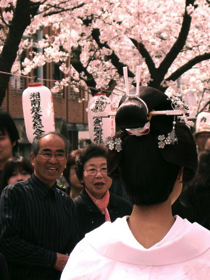
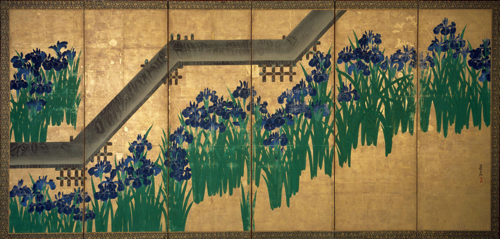
The Pine tree is another very important plant for the Japanese, associated with longevity and hardiness. We are fortunate to have been given 5 new Pines which are partially trained in the Japanese style by Dr. Andy Bolton from the Japanese Garden Society, who is also giving a lot of volunteer time to the garden. These are being planted this week and will be the focus of pruning workshops in the future to train and maintain their shape. Pine branches are used in the Japanese home for New Year symbolising continuity and prosperity for the household.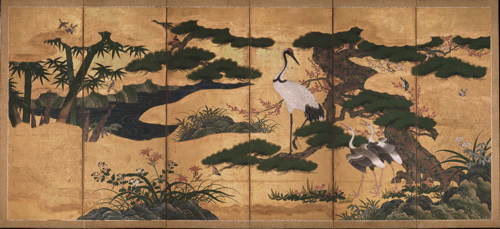
We already have several stands of Bamboo in the garden from the original planting, and indeed there is more on the island in the duck pond. In addition another kind local resident has donated two clumps of the golden stemmed Bamboo which we are considering planting near the main entrance arch into the garden. Bamboo is used extensively in Japan for everything from musical instruments, the Shakuhachi bamboo flute, and food as in fresh bamboo shoots, to fencing. It symbolizes strength and was always recommended as a place of refuge in an earthquake because the strong root structure holds the earth together. Bamboo is also flexible, so a man who is strong but adaptable would be referred to as a ‘bamboo character’, someone to be admired.
Spring will bring the flowers of the Camellia. We have chosen both red and white varieties. The red symbolizes ‘love’ and the white ‘waiting’. White flowers are a symbol of purity in many cultures, and a red rose for us is a red Camellia for the Japanese. Azaleas on the other hand are associated with modesty and humility, perhaps because the evergreen azaleas, which are the Japanese varieties, do not grow very tall. Again we have chosen both pink and white Azalea Japonica and will plant them in association with the stream in blocks of colour. 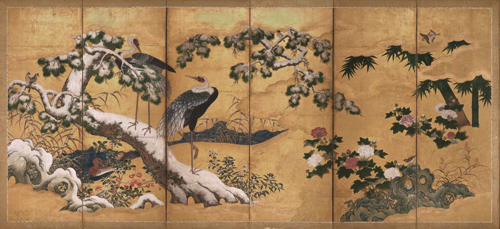
My visit to Batsford Arboretum to collect our Cherry tree will be the subject of the next blog, meanwhile there is work to be done…….
September 2017
Blog 2 of 2
BRIDGES AND GATEWAYS
This is a short blog with a few illustrations mainly to explain why we have chosen these particular styles of bridges and entrance gates for the Japanese Garden restoration.
If you have already walked through, you will know that we have two wooden bridges and one stone slab bridge. In Japanese stroll gardens, of which this is a very small representation, one will usually find a central area with a lake or a pond with a bridge leading onto an island, and paths leading around the water. In the larger gardens there are also other features such as arbors and tea houses. We cannot have these for reasons of space and finance.
We have concentrated on echoing the original 1930’s design to enable exploration around the garden, and for those fit enough, up to the high viewpoint where there is a solid oak bench to enjoy the view across Valley Gardens, and down onto a section of the Japanese Garden overlooking a triad stone arrangement and a glimpse of the arched bridge.
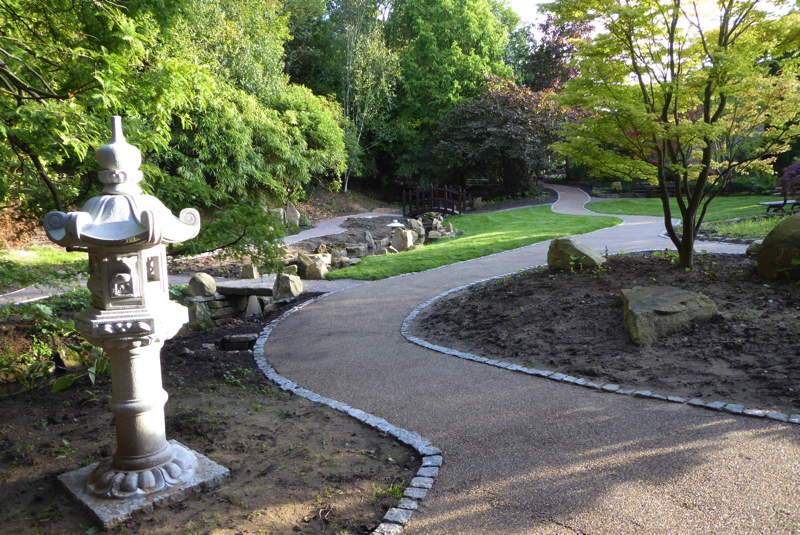
Stone Slab Bridge and Arched Bridge
This small arched bridge in the background is a typical oriental shape, although we have kept it shallow enough to avoid steps up either side, with Japanese style side rails and finials, but why is it not red? This was one of the main comments during our consultation, as people do tend to expect red bridges in Chinese and Japanese gardens like several in the UK, Compton Acre for example. There are two reasons, the main one being that in such a small space our designer did not wish the bridge to dominate, but to be harmonious. Secondly in Japan red bridges are reserved for very large gardens built by the Shoguns in the 17th century, and for shrines.
Chinese Inspired Lower Bridge
The lower flat wooden bridge is there to allow wheel chairs and larger push chairs to cross, enjoy a different view of the garden, then turn around to return the way they came. As far as we can make out from oral records there was originally a small bridge in this position. The larger bridges with cross bracing Chinese style rustic timber side rails were at either end of the boating lake. We have taken the opportunity to echo this design and reflect the heritage of the garden, although it is more Chinese than Japanese in style.
The stone slab bridge is a very common feature in Japanese gardens, and we are repeating one which was in the approximate position of the arched bridge; this one has four ‘guardian stones’ and I will have to find out the actual significance of these, on looking it up on the internet I could only find an exciting looking computer game! Presumably they act as protection. In a practical sense you can gauge the safe width of the slab.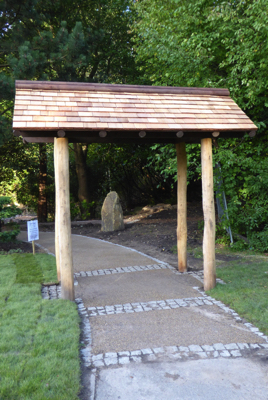
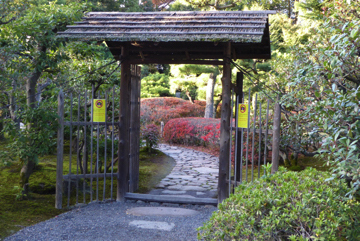
The Upper Entrance - the larger of the two and a similar gate at a garden located in Japan
Now onto the gateways. There were people at our consultation back in May 2016 who were really disappointed in the style of the arched entrance gates we showed, feeling that they were not sufficiently ornate. We hope, now that they are in position, that people will enjoy them. Constructed from Robinia poles and roofed with cedar shingles they do look lovely in the late afternoon sun. This style of simple roofed arch is used in Japan, particularly for entrances to tea house gardens, but tends to have bamboo gates attached. It is a simple construction to identify the boundary of the garden, and encourage the visitor to feel that the space within the garden is different. We felt that bamboo does not have a long enough life to use here, and that in a public garden which cannot be secured they could be subject to damage. 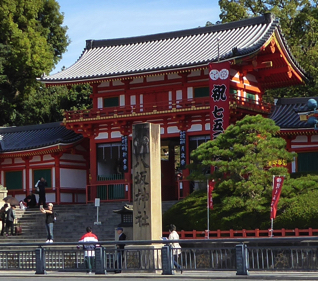
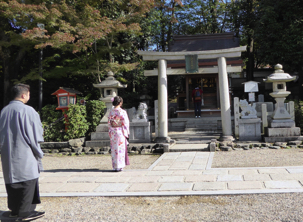
Entrance to a shrine in Kyoto and a simple Torii gate within a shrine. 

Views of the Grand Torii off Miyajima Island in Hiroshima Bay
The other style of entrance which people associate with Japan is the Torii gate; again these are reserved for shrines, and represent the movement from secular to religious space. There are some stunning ones, and on my trip I saw the Grand Torii Gate at Miyajima Island in Hiroshima Bay which is surrounded by water at high tide, and marks the entrance to the Itsukushima Shrine.
Next time I will blog about some of the plants we are planning to use and their symbolism. We hope you will enjoy walking through the garden and observing progress to the fully restored garden with us.
Again if you would like to be involved in any way please email Liz Chidlow at liz.chidlow@hotmail.co.uk. I can commend the Japanese Garden Society website for more information www.jgs.org.uk
Blog 1 of 2
As the main construction phase is nearing completion we now have all the elements of the restored garden in place except the new planting. This first blog of the month relates to Lanterns, blog 2 will cover Bridges and Gateways, and blog 3 Plants.
The security fence will soon be moved away as the contractors finish on site during the next few days then you will see what has been achieved so far.
LANTERNS
We have four splendid new lanterns to complement our garden; I am going to quote Robert Ketchell’s blog on ‘Symbolism of the Japanese Garden Part 3, Plants and Ornaments’ from July 2015 to help us understand their symbolism.
“Stone lanterns originally lined the approach path to shrines, and were incorporated into gardens by Tea masters from the 16th century. Lanterns (ishi tōrō (灯籠) are composed of five component parts, which relate to the five principal elements of Buddhist cosmology; earth
(地), water (水), fire (火), wind (風) and sky (空). The entire lantern is a symbolic map of the Universe.
The earth element (地) is represented by the foot, or stem, that part of the lantern that touches the ground; the earth element encapsulates the emotional qualities of stability and physicality. The earth element represents all that appears solid and with form, also that which appears not to change or at least to change very slowly.
The next section, on which the fire-box rests, represents the water element (水). In Taoist thought water represents the formlessness of things, inferring the qualities of adaptability, growth and development.
The fire-box section (the section of the lantern where a light would be set) represents the fire element (火). Fire represents movement or primal energy of the Universe. In human terms fire represents intention, will and desire.
The cap section of a lantern set over the fire-box represents wind (風), this element is associated with growth and expansion, and the human mind.
The very top section of a lantern that looks like a ‘bud’, pointing towards the heavens or sky (空) represents pure energy, or the transcendence of the material world. In human terms this section represents compassion and wisdom” (robertketchell.blogspot.com)
The Lanterns we have in the garden starting from the main upper entrance are a ‘Rustic Lantern’ which has been created by the stone mason Johnny Clasper from 5 stones he sourced from a farm on Penny Pot Lane, so they are very local to us and represent our local landscape being incorporated into the garden.
As you enter the main part of the garden you will notice a much smaller lantern by the side of the water resting on a large stone. This lantern reflects beautifully in the adjacent open water, it is called a yukimi-doro or snow viewing lantern. The shape of the cap section representing wind is a gentle dome to hold the snow and create a perfect picture in winter, hoping for snow this year. 
Thirdly as you walk down the main path looking straight ahead you will see a beautiful Kasuga Lantern. This is a generous gift from the Harrogate Flower Club giving the members a permanent reminder of all the enjoyable times they had together when they visit this garden. Hand carved from granite in China this very beautiful lantern, with its curled cap, originates from the Kasuga Shrine in Nara, Japan’s ancient capital. There are over 3000 of these lanterns at the shrine which are lit for special occasions. The deer you will find as a relief carving on the fire box section represents one of the many protected deer who live in the forest around the shrine.
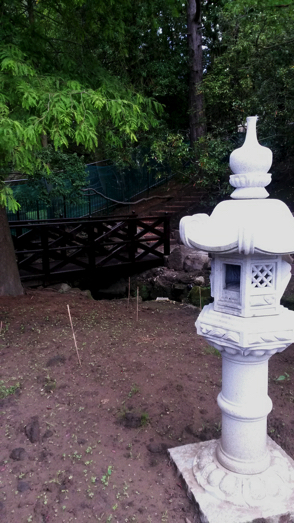
The tallest of our lanterns, at 2.2m high, is to be found on your left as wander through this peaceful place, the Pagoda lantern. Instead of being five sections this one has 16 sections with multiple fire boxes and caps with upturned eaves. This lantern has been generously donated by Jim Clarke and Don Mackenzie who have had to be very patient waiting for it to appear in the garden. They offered some of their Community Fund right at the beginning of the project, and the lantern has been waiting in store for the garden construction to have reached the right stage when it was safe to install it. As with the other three lanterns all the sections are glued together with strong weather proof resin glue, in addition they all have a steel rod drilled right through the centre into a firm concrete foundation. This form of lantern copies the pagodas built all across Asia, a tiered build with an odd number of stories with upturned eaves. The origin for these is the Stupa which was associated with storing relics and sacred writings. 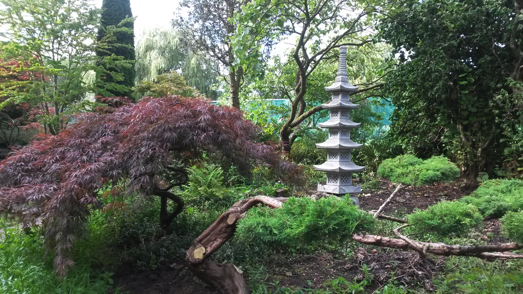
June-July 2017 - Looking at Rock Arrangements
Within our Japanese Garden there are now three distinct rock arrangements which have been created by the team from the Japanese Garden Society to whom we owe a big ‘Thank you’ for their time and effort.
Our designer Graham Hardman and his team identified suitable rocks at the quarry, and, with just a couple of variations, these are the rocks which have been used. Two of the rocks weighed in at 1.5 ton each! Handling rocks of this size so that they sit perfectly, both showing the best face and relating correctly with each other is a real skill and can take years to perfect. 
The accompanying photos will give some idea of how they look and the construction process, but to get the best idea you will need to come along and have a look once the contractors have finished, which is likely to be the end of August.
The Chairman of the Japanese Garden Society, Robert Ketchell, is an experienced Japanese Garden designer and did an apprenticeship in Japan. I have drawn from his online blog which I can certainly recommend if you are interested to research further. You will find it at www.robertketchellblogspot.com. The blog I quote concerns symbolism in the Japanese Garden.
Robert tells us that numbers and their symbolism are significant; the Shichi-go-san, 7-5-3 grouping is used in arrangements and you will see this with the Sacred Mountain arrangement and an arrangement of 3 rocks up at the top of the slope near the new bench. Each of these arrangements also has an outlying rock to signal towards the arrangement as you approach it.
Sacred Mountain Arrangement
Three Rock Arrangement
He also describes that the earliest gardens created in Japan were a recreation of the Buddhist paradise. According to legend paradise lay off the coast of China as a series of 5 towering islands, each of them blessed with sparkling streams and luxuriant flora and fauna, including mushrooms which guaranteed immortality to anyone who consumed them. All these islands were supported on the backs of giant tortoises. After a confrontation with a giant, two of the islands were lost leaving Penglai, Yingzhou and Fanghu. According to legend anyone who achieved eternal grace would be transported to these isles borne by cranes, a bird that has long been associated with mystical qualities. Depictions of Tortoise (Kamejima), Crane, (Tsurujima) and islands have been a feature of Japanese gardens for centuries.
Our garden contains both the turtle island and the crane which you can see illustrated below. Both these arrangements look very realistic when viewed from within the garden. I hope that children walking round will identify the Turtle by the rock which forms his head, from one angle it looks almost real!

Turtle with head facing left
Crane with head facing left
In another blog I will talk about the symbolism of plants and lanterns.
The construction work continues steadily and we are looking forward to the arrival of our bridges, and to seeing Johnny Clasper’s designs completed.
May 2017 - Main Contractors Start Work
May has been a busy month for the contractors with some mixed weather. The site has been well secured by fencing covered in green netting which allows the public to see through and observe progress; popular with small children too when they catch site of a big orange dumper truck and a digger. 
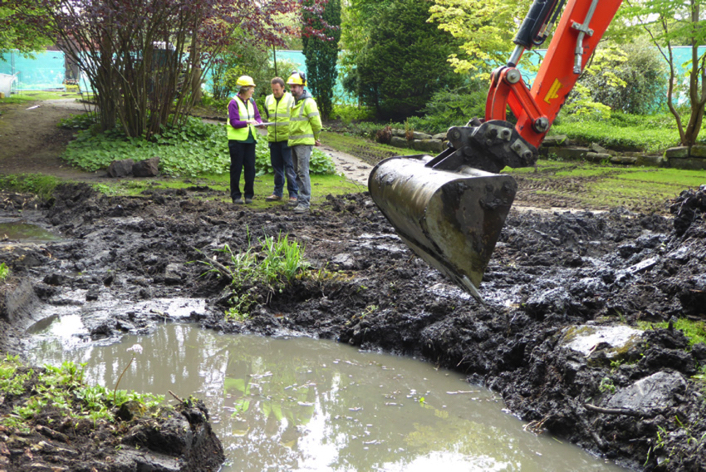
As you can see from some of the photographs the pond and stream have been cleared of sediment, which was left to drain before being taken off site. Care was taken with the invasive American Skunk Cabbage and the Umbrella plant rhizomes which were bagged and taken to a special area for disposal. The reshaping of the stream and ponded area, with additional rocks to be placed all along it, is scheduled to commence the week beginning June 6th when the Japanese Garden Society specialist team make a return visit.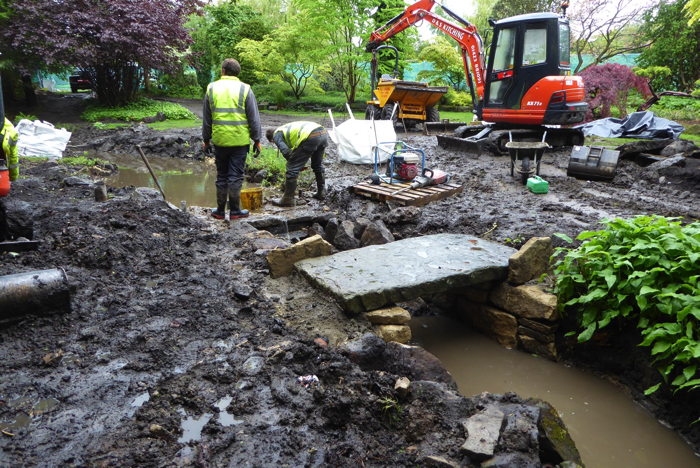
The old fence adjacent to the boating pool has gone, and a new one in the same style will be fitted later. The new woodland path and steps up the hillside have been created. A beautiful oak bench ( see the photograph) made by TWS Site Manager Robert Wood, who is also the firm’s specialist carpenter, has been securely fitted at the top of the slope giving a view across the garden. We have installed some new drainage for the grassy area where the two benches will be, and tried to control the spring which was always running across the main path. The turning area for wheelchairs is being shaped and seepage from the hillside drained down into the stream; so we hope these measures will alleviate some of the problems with muddy feet during wet weather. 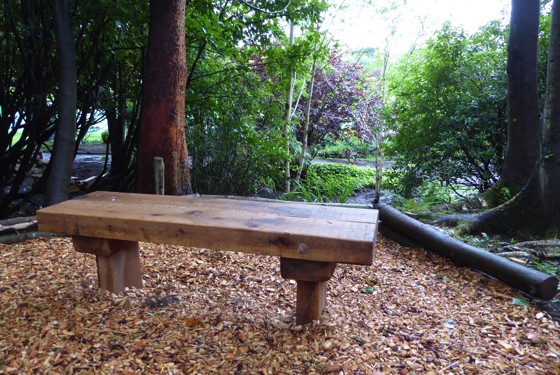
Five members of The Japanese Garden Society from the Manchester area plus one from Tockwith, have spent 3 days creating three rock arrangements of which more later. They are due back in June after half term for another three days and will tackle more rock work. The three rocks in one of the photographs of the woodland path were removed from the island bed where they had been providing edging stones and now have a new life at the top of the hill looking as if they have always been there. Positioning rocks to look natural is a great part of creating a Japanese Garden and I plan to write a blog just about that next. 
The Community part of the project is moving steadily along, although Grove Academy horticulture students are now looking after our plants in their own garden at Grove House. The Harrogate High School GCSE art group has now commenced their module on Japanese Art, kicked off with a talk from Graham Hardman the garden’s designer, on the design process using Japanese garden plans as a basis for their exercises. In addition they have a workshop on Chinese Brush Painting planned for mid-June as part of the project. Anne Allan from the Chinese Brush Painting Society will bring all the materials for a 2 hour session and show the students how to paint camellias, bamboo and butterflies in the Chinese way using coloured inks and special brushes and paper. We look forward to seeing some of their work which will be displayed in due course.
So cheerio until next time when I will blog about Japanese Mythology and rock arrangements. The main contractors are making great progress as can be seen in the photos.
Woodland Bench
April 2017 - The End of Phase One
As we reported in March the clearing phase which has been carried out by the gardening volunteers, Grove Academy students and staff, and Horticap students and staff has now finished. 22 Volunteers have put in over 250 hours of gardening time in addition to the hours by Grove Academy and Horticap. The Valley Gardens’ permanent staff has helped us to remove 18 trailer loads of material for composting, leaving the garden in much better condition and ready to move forward with the restoration.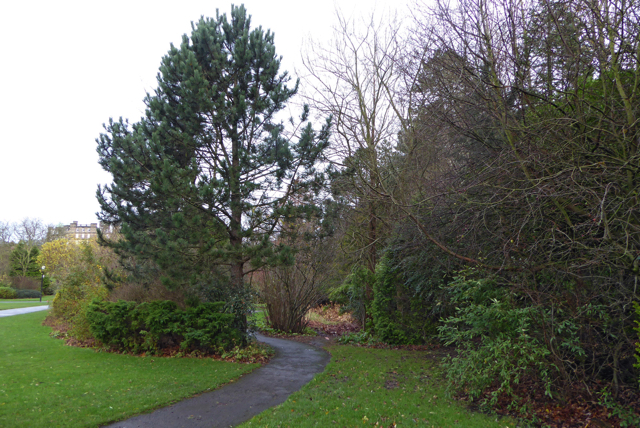
Upper Entrance before clearing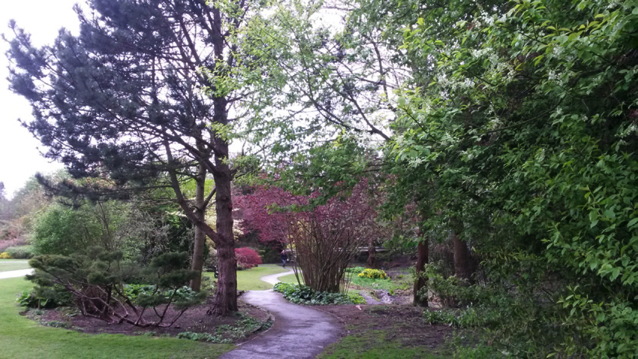
Upper Entrance after clearing
Students have been involved in pruning shrubs into shape, potting up the ground cover and perennial plants we want to save, and even digging out a large clump of bamboo which was in the way of the new path to the lower bridge.
We have enjoyed taking stock of wildlife in the garden but not always had the time to photograph them. We did catch a Comma butterfly. 
We have taken care of the frogspawn so that the tadpoles will have a better habitat in which to develop this year away from the machinery, spotted a pair of bullfinch and been serenaded by robins as they claim their territory.
Our designer Graham Harman and his team from the Japanese Garden Society have chosen the rocks for the new features from a York stone quarry on the edge of Huddersfield, and will start the installation later in May.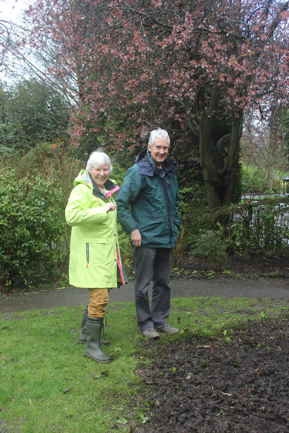
Designer Graham Harman and Project Co-Leader Ann Beeby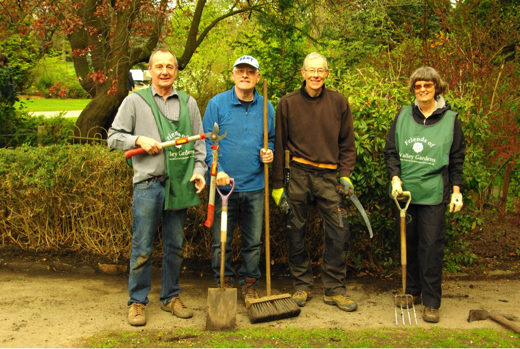
Japanese Garden Volunteers including Project Co-leader Liz Chidlow
The arrival of the main contractors at the end of this month will mean that the site is closed off for some weeks whilst the groundwork is done, the watercourse desilted and reshaped and new paths created.
March 2017 – Volunteer Gardeners Prepare the Way
The weather has generally been kind to the volunteer gardeners and the results of their weekly labours of love in managing the trees and shrubs are beginning to give us an idea of the shape of the restored garden.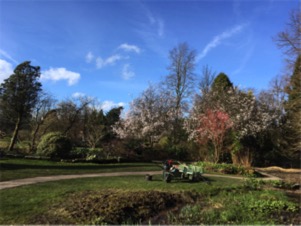
The tools we bought have already been put to good use. We have been very busy pruning out dead and damaged woody material, and local tree contractors helped by removing dead and overcrowded trees, so opening up the tree canopy, views and the way for the paths. We were excited to uncover the base of one of the original Japanese lanterns in the Garden, which you can see in the photo below. 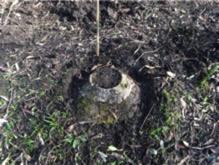
Some shrubs, which are not characteristic of Japanese gardens, have been re-located elsewhere in the Valley Gardens, to prepare the way for new planting starting later in the year.
Horticap have helped us tackle some large clumps of bamboo which we needed to cut down to make way for paths; other bamboo clumps we have thinned to create the feel of being able to ‘look through’ to the garden beyond. 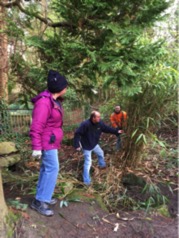
Grove Academy student Tom, with his supervisor Pauline, have pruned the holly and Berberis into shape as you enter the garden, and now you can see glimpses of the reflection of the café in the boating pool, and the beautiful shape of the bark on the nearby dawn redwood tree. 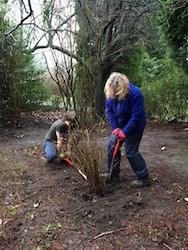

A little more gardening to do up to Easter and then it is the Contractor’s turn…..
February 2017 - Cloud Pruning of Juniper
Specialist pruners Steve and Jo from the North West branch of the Japanese Garden Society have paid their first visit to our garden to work their magic on a mature Juniper which was threatened with the chop. Click on the photo below to see a video of their work and the final results. Shall we keep it?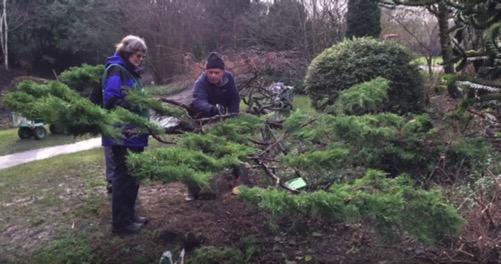
January 2017 - Japanese Garden Project Launch
On Tuesday January 17th the Japanese Garden Project was officially launched in the presence of the Mayor, a representative from Heritage Lottery, and volunteers from all the groups represented, a grand total of 59 people.
It was a very happy affair with plenty of opportunity for different groups to interact and the weather stayed dry, which was a bonus. Adrian Murray took some excellent photographs, and we got a good report in the Harrogate Advertiser, with one of the photos showing the whole crowd. Sue Mendus, from Heritage Lottery thanked us for an excellent event which she thoroughly enjoyed.
Our first ‘spend’ from the grant money was for tools to be used by our gardening volunteers and students from Grove Academy. The shiny new stainless steel spade was duly plunged into the soil by the Mayor, Cllr Nic Brown, who was wreathed in smiles, to declare that work can now officially start.
Since then we have had a good turnout for gardening each Tuesday and have made great progress with pruning out dead and overgrown shrubs from the woodland and clearing areas where paths are planned to be.
The administrative work necessary for contractors to be appointed etc is on track, so I am delighted to say that we are definitely underway.
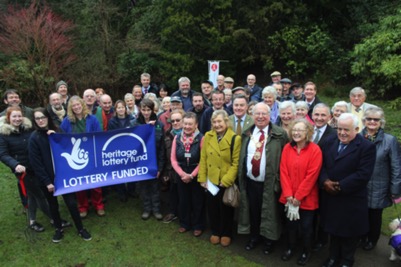
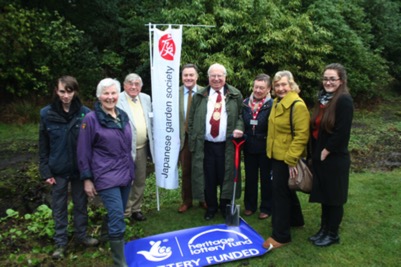
December 2016 - Just in Time for Christmas, A Heritage Lottery Award for the Japanese Garden Restoration
Well we have done it, almost a year to the day I first registered with HLF in Leeds, we have today received official permission to start our project.
Early in the New Year a partnership agreement for the duration of the project will be finalised with Harrogate Borough Council who are working with us to deliver the restoration of the Japanese Garden.
There will be regular bulletins on this page about our progress, the planned community activities, and opportunities to volunteer.
We can all look forward to an exciting year ahead, during which the main part of the construction should be completed.
So Watch This Space…………………………………………………!
October 2016 - Autumn Colours and Shrub Planting Plans
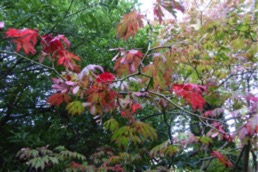
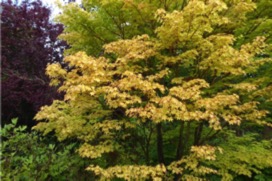
This watercourse area is where we have a lot of work to do, you can see how it is entirely silted up and growing a good crop of buttercups, hopefully by this time next year we can show a very different picture.
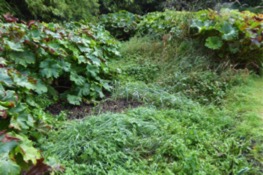

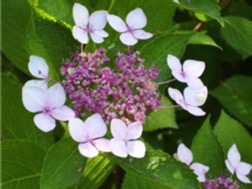
And finally for this month a picture of the beautiful golden bamboo, Phyllostachys Aurea, which will be a feature of the new entrance arch at the southern end of the garden. This variety grows up to 10m high in the right conditions, and is a clump forming variety and so easier to maintain.

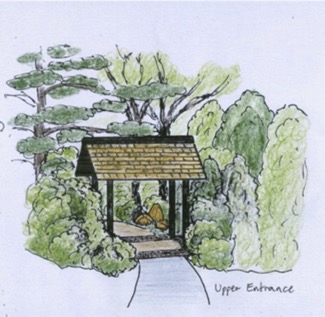
July 2016 in the Japanese Garden
Everything is growing up now in the garden and the watercourse is completely concealed by tall planting which has taken over. The hazel is looking a good colour and the trees are in full leaf. We have managed to commence control of the invasive Skunk Cabbage which is a bonus, but as you can see there is now no water at all in the ponded area. The frogs did manage to lay some frog spawn earlier in the year, but despite what we feel has been a wet season, there is nothing to show as the silt has filled the area completely.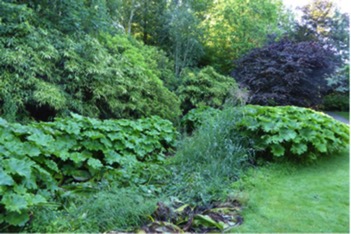

The project is moving forward slowly although it must appear that nothing is happening. The plans are finalized, the consultation process is complete and has been a positive exercise with many people getting involved and some good new contacts made.
We are getting costings now from contractors and finalizing our partnership with Harrogate Borough Council. They will need to complete a partnership agreement before we can submit an application to Heritage Lottery which we now hope to do in September.
Community Involvement
We would be delighted to meet any of you who are interested in becoming involved with this project either individually or as a group. We are happy to come and talk about it to groups, so do get in touch.
Horticap have agreed to help us to tidy up the woodland area during the winter when they are not so busy with regular clients.
There are several school projects associated with the restoration. Grove Academy Horticulture Department is going to be involved throughout the project and have expressed interest in assisting with the future maintenance of the garden which is great.
A recent talk to Harrogate and Nidderdale Art Group should result in some paintings for their Autumn Exhibition at Ripley in late November which will reference the garden and the new design with the artist’s vision of the project.
We have agreed with Rossett School that they are going to assist with the layout and graphics for the creation of information panels for when the garden is completed, and they will also design publicity leaflets for distribution around Harrogate.
Harrogate High School are very interested in our Project and plan to include modules on Japanese Art and Culture for the Art GCSE students with a workshop sponsored by the project to give the inspiration.
We would also like to plan something for the infant and Junior age group but this has yet to be agreed.
Our links with the Japanese Garden Society are strengthening and we hope for a long association with them and to be able to learn from their expertise.
So a very positive situation, but this is all dependent on getting a grant from Heritage Lottery, so wish us luck.
May 2nd – 9th 2016
Consultation on the draft plan for restoration of the Japanese Garden at St Peter’s pending a Heritage Lottery Application this year.
The Japanese Garden group from the Friends set up an exhibition in St Peter’s Church foyer as part of the Consultation which is being carried out online by Harrogate District Council our partners in this venture, we had good volunteer support to enable us to staff the exhibition from 10.00am -5.00pm every day, so thank you everyone for your help. 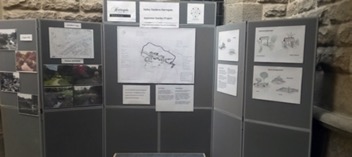
The Japanese Shop lent a bright red kimono and a mannequin, and a bright parasol.

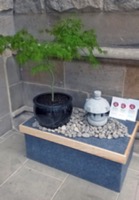
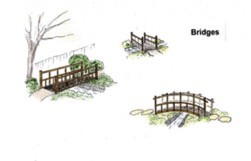

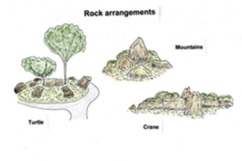
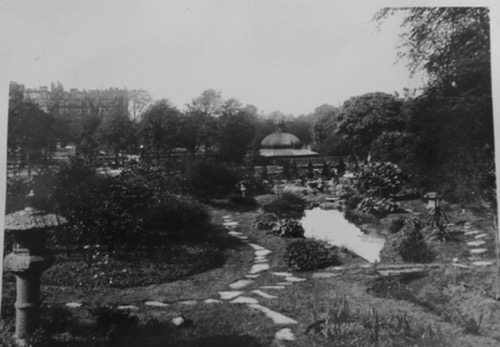

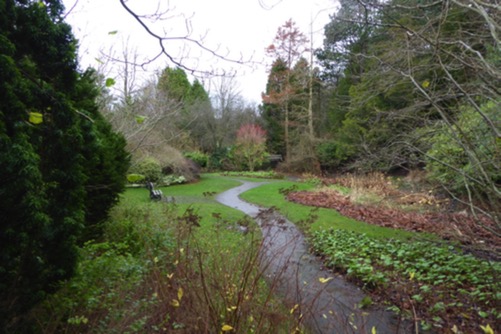
Provided we can get all the permissions and agreement with HBC together with full costing of the plan we hope to get the application in by September, which if we are successful at the first attempt will enable us to start the work on the watercourse and woodland during the winter months.
A big part of this application is the Community involvement and I will talk about that in a future blog. Meanwhile I attach a summary from the report of our week which was extremely positive.
Report of comments recorded ‘in situ’
254 visitors came to see the display over the whole period. Most were local to Harrogate and District with some from the Leeds City Region and a few from other parts of the country and abroad e.g. USA. One person designed Japanese gardens in New Zealand. Some came from the groups we have already involved e.g. Harrogate and Nidderdale Art Club, Grove Academy. The majority of people were not aware that there was a Japanese Garden in the Valley Gardens.
“When I was a child I remember that children were not allowed in the Japanese Garden, when I did eventually get there it was rather a disappointment” she went on to say that we should be doing something better now as people’s expectations are greater.
The overall response was extremely positive with 99% supportive of the proposed plan. Of the one or two exceptions, one lady did want any change to the Valley Gardens and another wanted English garden plants. The large majority of people thought it was interesting, exciting and would look both distinctive and lovely, moving forward a garden which was becoming more ordinary. They felt that it was good to have a specific use for that space and it should attract visitors.
‘So nice to have something good happening in Harrogate’
People also said it would be peaceful and that Harrogate needed a calm place amidst the stress. They were impressed with and welcomed the community involvement. A number of very useful comments for the design, activities and contacts were made. Many people had personal connections with Japan or had visited the country and one or two involved with garden design or other horticultural aspects. Just one lady believed that Harrogate Gardens should all reflect ‘English plants’ and local views.
People asked about when the project would start and how it would be funded. It was emphasised that it would be funded externally, not by the council, and that we were going to try and get heritage lottery funding. .